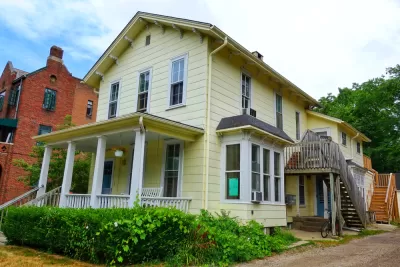Accessory Dwelling Units continue to gain steam as one approach for increasing affordability, but experts caution that housing affordability requires broader solutions.

Cities and states across the country are realizing the potential of legalized Accessory Dwelling Units (ADUs) as an inexpensive way to increase density and available housing units without drastically changing a neighborhood's character. According to Kol Peterson, author of Backdoor Revolution: The Definitive Guide to ADU Development, "there has been a dramatic uptick in ADU regulatory relaxation over the last few years." In a piece for the Washington Post, Haisten Willis assesses the benefits of ADU construction, which is experiencing a resurgence, particularly in high-cost, low-density neighborhoods on the West Coast.
California and Oregon have passed statewide legislation legalizing ADUs, and Chicago is implementing a pilot program to test the concept. Between 2016 and 2019, ADU permits in California jumped from 1,269 to 14,702, signaling a pent-up demand for "granny flats." Los Angeles, which issued 80 ADU permits in 2016, issued 6,747 in 2019.
The ADU can be an ideal housing type for seniors who want to live near their family and provides an unobtrusive way to increase available units, but advocates admit that "the devil is in the details" and more oversight is required to ensure ADU landlords can navigate the process and maintain adequate living conditions. "It still doesn’t absolve the city from the protections they need to keep for renters," says organizer Ebonée Green. Homeowners who want to build ADUs don't always know how to manage contractors or get permits, and banks, unfamiliar with the construction type, have so far been reluctant to issue loans for ADU projects.
While the growth in ADU construction is encouraging, experts warn that legalizing ADUs is only "a small tool in the box," not a broad solution to housing affordability issues.
FULL STORY: Accessory dwellings offer one solution to the affordable housing problem

Alabama: Trump Terminates Settlements for Black Communities Harmed By Raw Sewage
Trump deemed the landmark civil rights agreement “illegal DEI and environmental justice policy.”

Planetizen Federal Action Tracker
A weekly monitor of how Trump’s orders and actions are impacting planners and planning in America.

Why Should We Subsidize Public Transportation?
Many public transit agencies face financial stress due to rising costs, declining fare revenue, and declining subsidies. Transit advocates must provide a strong business case for increasing public transit funding.

Understanding Road Diets
An explainer from Momentum highlights the advantages of reducing vehicle lanes in favor of more bike, transit, and pedestrian infrastructure.

New California Law Regulates Warehouse Pollution
A new law tightens building and emissions regulations for large distribution warehouses to mitigate air pollution and traffic in surrounding communities.

Phoenix Announces Opening Date for Light Rail Extension
The South Central extension will connect South Phoenix to downtown and other major hubs starting on June 7.
Urban Design for Planners 1: Software Tools
This six-course series explores essential urban design concepts using open source software and equips planners with the tools they need to participate fully in the urban design process.
Planning for Universal Design
Learn the tools for implementing Universal Design in planning regulations.
Caltrans
Smith Gee Studio
Institute for Housing and Urban Development Studies (IHS)
City of Grandview
Harvard GSD Executive Education
Toledo-Lucas County Plan Commissions
Salt Lake City
NYU Wagner Graduate School of Public Service





























